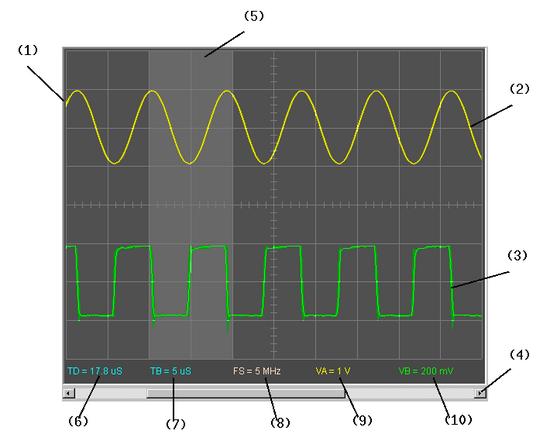
The primary display is where waveform, spectra and logic data are rendered.
It supports a range of layouts and data formats suited to each Virtual Instrument.
This is probably the most familiar DSO display; a dual trace digital oscilloscope.
(1) Display Graticule: all waveforms are displayed on the 8 x 10 graticule.
(2) Channel A Trace: Channel A trace drawn in yellow.
(3) Channel B Trace: Channel B trace drawn in green.
(4) Waveform Offset: used to scroll both waveforms left and right.
(5) Zoom Band: indicates where the zoom timebase will operate (when enabled).
(6) Trigger Delay: time of the left edge of the display referenced to the trigger.
(7) Timebase: the prevailing timebase setting (time per division).
(8) Sample Rate: display sample rate (note this may be different to the capture rate).
(9) V/Div Channel A: vertical scaling channel A (volts per division).
(10) V/Div Channel B: vertical scaling channel B (volts per division).
By default the timebase zoom is set such that the display shows 1/2 of the total capture buffer (ie, the waveform offset slider (4) is 1/2 of the display width). This makes it easy to scroll any feature of the waveform onto the display.
When used to capture analog and logic signals the default is a split analog and logic display.
(1) Analog Display: analog trace displayed on the 8 x 10 graticule.
(2) Logic Display: 8 logic traces displayed concurrently with the analog trace.
(3) Analog Info: same information set as the dual channel analog display.
(4) Logic Info: a sub-set of information pertaining to the logic display.
(5) Waveform Offset: used to scroll both analog/logic displays left and right.
If viewing only logic or analog captured in mixed mode, the split display can be turned off to show just logic (or analog) using the full display. The timebase zoom in mixed and logic VIs are usually set more "zoomed in" than in other modes because usually you're looking for timing detail rather than overall analog waveshape. Of course you can adjust the timebase zoom at any time to suit your preference.
Several spectrum display formats are available. This one shows magnitude and phase.
(1) Magnitude Spectrum: waveform magnitude (amplitide) spectrum in dB (10 dB/Div).
(2) Phase Spectrum: waveform phase spectrum (90 Deg/Div).
(3) Spectrum Bandwidth: Full spectrum bandwidth (250 kHz in this case).
(4) Sample Rate: Capture sample rate (Hz).
The spectrum analyzer displays are tightly integrated with the main DSO controls; sample rate, spectrum analyzer bandwidth and reference levels are all set using standard DSO controls (ie, timebase and channel V/Div). As with other displays it is possible to turn off the split display to show just the magnitude spectrum using the full display.
Frequently it is desirable to see the waveform a spectrum together.
(1) Magnitude Spectrum: waveform magnitude (amplitide) spectrum in dB (10 dB/Div).
(2) Waveform Display: waveform time display (V/Div per channel).
(3) Channel B: Channel B waveform display (square wave).
(4) Channel A: Channel A waveform display (rounded sawtooth).
(5) Channel B: Channel B magnitude spectrum (first harmonic).
(6) Channel A: Channel A magnitude spectrum (first harminic).
This example shows both channels' waveform and magnitude spectra simultaneously.
The display mode is Dot/Vector (ie, high resolution) and all the DSO controls remain available allowing you to (for example) zoom in on a region of waveform an look at the spectrum of the region simultanouesly or enable cursors in both time and frequency domains to make concurrent measurements in the two different views of the signals.
This was done on SYDNEY so you can try this yourself, even if you don't have a BitScope handy.